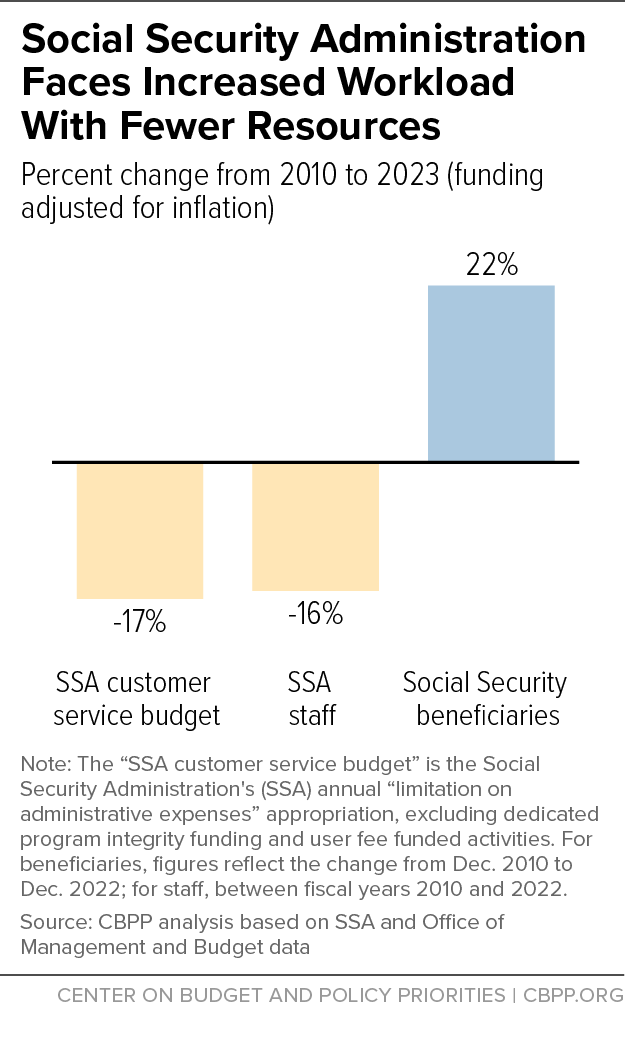BEYOND THE NUMBERS
The Social Security Administration (SSA), which has been struggling to serve the public after over a decade of restricted funding, has a chance to turn things around next year — but only if appropriators provide a funding boost. For years, Social Security applicants and beneficiaries have had to deal with long hold times on the phone, lines outside field offices, and record-long waits for disability determinations. With additional funding for the coming year, the agency could invest in the staff and technology it needs to better serve the public.
Since 2010, SSA’s customer service budget has fallen by 17 percent, after inflation, with its staffing falling a commensurate 16 percent — marking the lowest level in 25 years. These cuts happened even as the number of Social Security beneficiaries grew by almost 12 million, or 22 percent. (See chart.) Being forced to serve millions more people with fewer staff and resources has caused tremendous strain at SSA, and beneficiaries are suffering the consequences.
President Biden has requested an increase of 10 percent (about $1.3 billion) in Social Security’s customer service budget in 2024, which would allow the agency to begin to restore service to an acceptable level. About half of the President’s request would cover fixed cost increases, such as salary, benefits, and rent increases. The remainder would be used to begin to improve SSA service — an important first step in what must be a multi-year rebuilding effort. According to SSA, at the level included in the President’s 2024 budget, the agency could:
- Improve field office service by adding the equivalent of another 375 field office employees, expanding the agency’s new self-service appointment system, and improving online services — for example, by allowing e-signatures on more documents so that fewer people need to come to offices in person.
- Speed up telephone service by adding the equivalent of 284 teleservice center staff, providing them more training, and improving SSA’s telephone technology. The agency expects these investments will reduce busy rates from the current 15 percent down to 3 percent and average hold times from 35 minutes to 20 minutes.
- Expedite disability decisions by adding the equivalent of 943 employees to state disability determination services and improving the agency’s iAppeals system. This would allow the agency to process over 500,000 additional disability claims in 2024.
- Hasten disability appeals by hiring the equivalent of 99 hearing office staff, including administrative law judges. This would allow the agency to process over 100,000 additional disability appeals in 2024.
The independent budget, which the SSA commissioner is required by law to submit to Congress, requested about a billion dollars above the level in the President’s budget. This increase in funding would allow for even more hiring, technology investments, and improvements in customer service.
Meanwhile, House Republicans have reportedly pledged to cut discretionary spending back to 2022 levels in 2024. If SSA received an appropriation in 2024 identical to its 2022 level, the effects would be devastating, requiring field office closures, reduced hours, staff furloughs, and degradations on every metric of customer service. And it’s likely the proposed cuts would be even deeper.
Policymakers’ reluctance to cut defense funding and veterans’ medical care would likely force far larger cuts in other non-defense program areas — like Social Security customer service — if overall discretionary funding were ratcheted back to its 2022 level. SSA reports that cuts beyond the 2022 level “would be catastrophic for the agency and for the people depending on Social Security programs supporting their daily needs. For every $100 million below [2022 levels], we would have to lay off an additional 1,000 people, further undermining services to the public. Every 1,000 staff layoff is the equivalent of closing over 40 field offices.”
Policymakers should reject another round of austerity and instead work to rebuild SSA’s customer service capacity. They should provide at least as much funding as the President has requested to improve access to Social Security, one of the nation’s most important programs.

